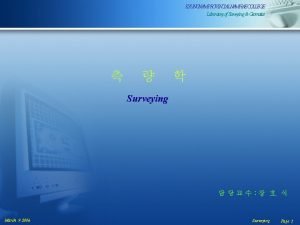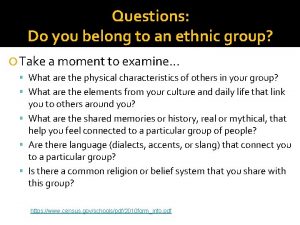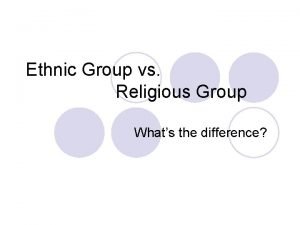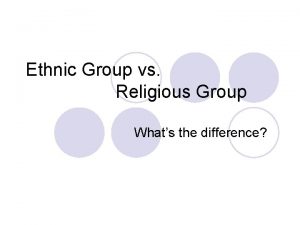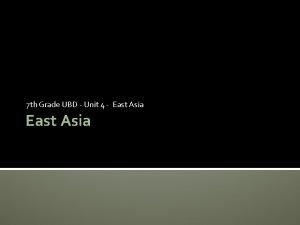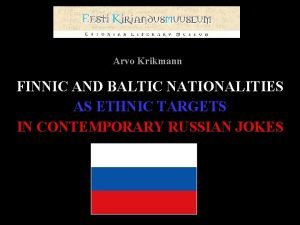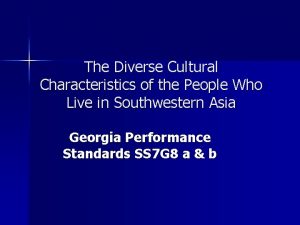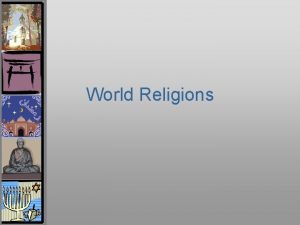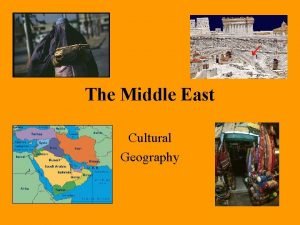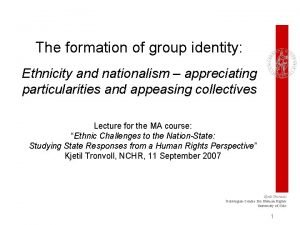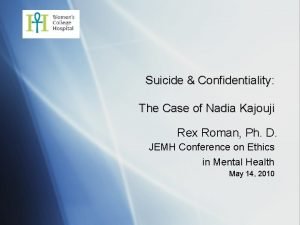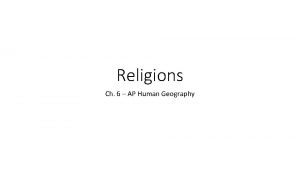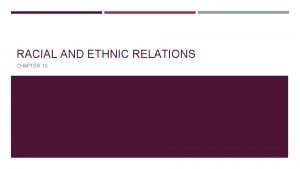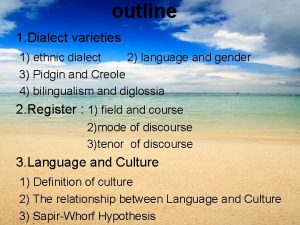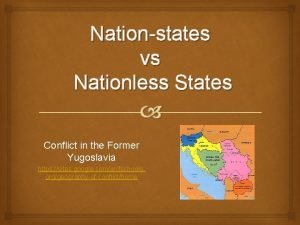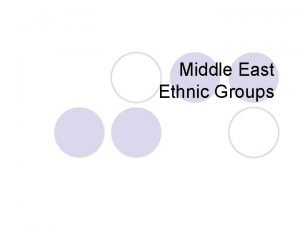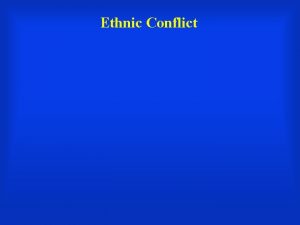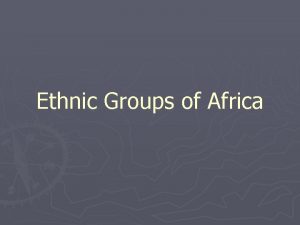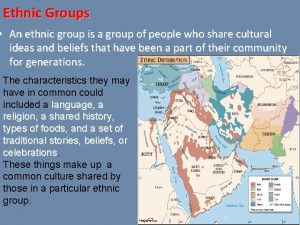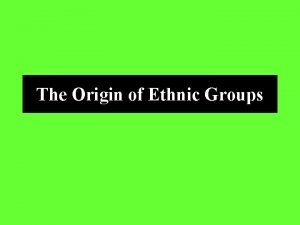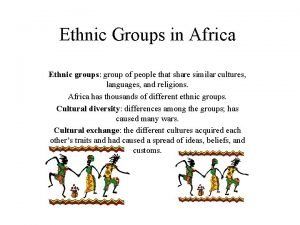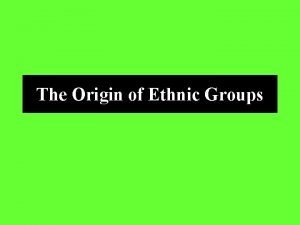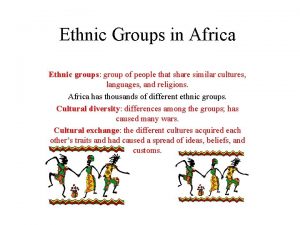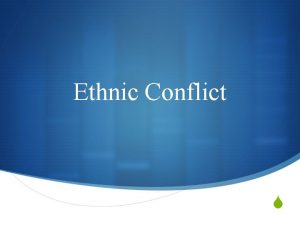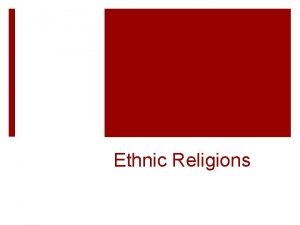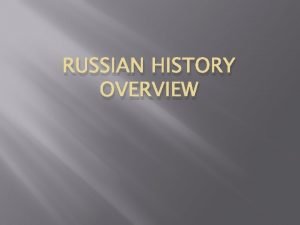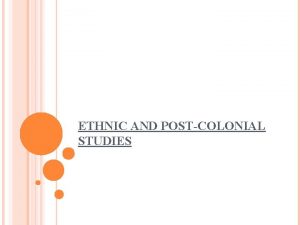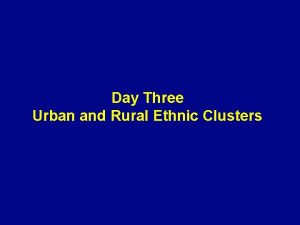Lecture 3 Ethny ethnic group 8 March 2006






















- Slides: 22

Lecture 3: Ethny (ethnic group) 8 March 2006

Ethnicity • Historically largely within the field of anthropology • Central focus on the concept of culture • Terms ethnic, ethny and ethnic relations escape the problematic nature of the term race

Ethnicity - ethnic group • the term ethnicity first appeared in English in the 1950 s; it has various meanings: a particular ethnic group, ethnic identity, the essence of ethny, belonging to ethny, field of study. . . • Greek adjective ethnikos: referring to heathens, the ‘others’, foreign; meant gentile • derived from Greek noun ethnos: people, unity of people with common blood or descent; sharing some biological or cultural characteristics (it referred to a basic human category, not a subgroup) – but others, e. g. foreign barbarians were referred to as ethnea • 15 th century in English ethnic meant somebody not Hebrew, not Christian; a pagan --> non-ethnic ‘us’ & ethnic ‘others’ • ethnic ceased to be related to ‘heathen’ in the early 18 th c.

Some related concepts • Ethnic identity: • individual level of identification with a culturally defined collectivity, the sense of an individual that they belong to a particular cultural community

Some related concepts • Ethnic origin: • refers to the individual’s sense of ancestry and nativity; connected to one’s parents and grandparents • problematic collective dimension: migrational origins of ethnies => ethnogenesis

Some related concepts • Ethnocentrism: the sense of one’s own group’s uniqueness and centrality in relation to other ethnies • The belief that your own group's cultural traditions and values are correct and superior to all others. It is often coupled with dislike and even contempt for people who have other cultural traditions.

Some related concepts • Ethnicism: rarely used • Movements of protest and resistance by ethnies and on behalf of ethnies against exploitative and oppressive outsiders • (John Hutchinson & Anthony D. Smith “Ethnicity” Oxford Readers, 1996)

No agreed upon definition • Various levels of incorporation: ethnic category, ethnic network, ethnic association, ethnic community (nation) => • ethnic category v ethnic community

Richard Schermerhorn (Comparative Ethnic Relations, 1970) • “An ethnic group is. . . a collectivity within a larger society having real or putative common ancestry, memories of a shared historical past, and a cultural focus on one or more symbolic elements defined as the epitome of their peoplehood. . . A necessary accompaniment is some consciousness of kind among members of the group. ”

Manning Nash (The Cauldron of Ethnicity in the Modern World, 1989) • “The most common ethnic identity markers. . . are kinship, . . . commensality, . . . and a common cult. . . This trinity of boundary markers and mechanisms is the deep or basic structure of ethnic group differentiation. It is the presence of cultural markers of blood, substance, and cult that separates ethnic groupings from other kinds of social aggregates, groups, and entities. ”

Fredrik Barth (Ethnic Groups and Boundaries, 1969) • “ethnic groups are categories of ascription and identification by the actors themselves. ” • the ethnic boundary defines the group • “ethnic categories provide an organizational vessel that may be given varying amounts and forms of content in different socio-cultural systems. They may be of great relevance to behaviour, but they may not be. ”

Clifford Geertz (Old Societies and New States, 1963) • “By a primordial attachment is meant one that stems from the ‘givens’ – or, more precisely, as culture is inevitably involved in such matters, the assumed ‘givens’ – of social existence: immediate contiguity and kin connection mainly, but beyond them the givenness that stems from being born into a particular religious community, speaking a particular language, or even a dialect of a language, and following particular social practices. These congruities of blood, speech, custom, and so on, are seen to have an ineffable, and at times overpowering, coerciveness in and of themselves. ”

6 main features of ethnies: (Hutchinson & Smith, 1996) • • • common name myth of common ancestry (shared origin) shared historical memories elements of common culture a link with a homeland sense of solidarity

Culture (Fenton, 1999) • The concept of culture is a central one but also a tantalising one • Material culture: the objects created, the material reproduction of human societies • Symbolic: valued styles and ways of life, manners, customs, rituals. . . • Emphasising the importance of learning: socialisation v innate bio-psychological universals => seemingly endless variation in the construction of cultures

Culture (Fenton, 1999) • How does culture construct group boundaries? • “Culture should not be thought of as a fixed quality; cultures shift both in small incremental steps and in seemingly dramatic moments wherein we imagine we glimpse the end of a way of life or the beginning of a new one. Neither should it be thought of as ‘attached’ to a group, community, nation or people in such a way that we can, without qualification, define ‘this people’ as the people who share ‘this culture’. . . Devotion to specific cultural forms varies across a group and the forms are frequently contested and constantly being defined and redefined. ”

Culture (Fenton, 1999) • Language • A powerful group marker but • Languages stretch across many groups who may think of themselves as ethnic groups – ethnically distinct • If the language is a part of an ethnic (or national) claim, it is the most important mechanism of the boundary-making process • If unknown to outsiders, it is a means of social exclusion

Different contexts of ethnicity • Ethnicity is both material and symbolic; it is both grounded and constructed: • Ethnic categories shift and change their content as circumstances change & • Ethnicity also has a ‘real’ social basis in the enduring importance that people attach to ancestry, language, culture

Concepts of ethnicity • American sociological tradition: ethnic groups are parts of a larger society; ethnies are always minorities within a nation or national state • ‘objective’ and ‘subjective’ approaches: • O: emphasis on cultural traits (language, religion, culture, customs, ‘racial characteristics’) • S: emphasis on the contextual meaning and the fluidity of ethnic identity

Different ‘types’ of ethnic groups (Eriksen, 1993) • • • Urban ethnic minorities Indigenous peoples Proto-nations (ethnonationalist movements) Ethnic groups in plural societies Post-slavery minorities (added by Fenton)

Bringing in the ethnicity • after the atrocities of the Second World War and the Holocaust and anti-Semitism, the word ‘race’ became problematic • the word ‘ethnicity’ becomes the preferred choice for expressing intergroup differences • especially from the 1960 s onward; anti-colonial, anti-racist arguments => ethnicity expresses positive feelings of belonging to a cultural group • after the collapse of communism more negative aspects of ethnicity come to the fore (esp. because of ‘ethnic cleansing’) • but - the persistence of race. . .


Lecture 4 reading list: • • • From “The Ethnicity Reader” (Guibernau & Rex, 1997) read Anderson From the “Nationalism” Oxford reader (Hutchinson & Smith, 1994) anything from sections I, II and III or go straight to the source: Anthony Smith The ethnic origins of nations, pp. 6 -13, 16 -18 Benedict Anderson Imagined communities, pp. 5 -7 Ernest Gellner Nations and nationalism, pp. 1 -7 + ‘Adam’s navel…’ in Mortimer & Fine People, Nation and State (pp. 31 -35) + Smith ‘The Nation: Real or Imagined? ’ (ibid. ) (pp. 36 -42) ----- • • Eric Hobsbawm Nations and nationalism since 1780, pp. 8 -13 Michael Hechter Containing nationalism pp. 5 -9 Craig Calhoun Nationalism pp. 1 -8 Montserrat Guibernau Nationalisms pp. 46 -51 Rogers Brubaker Nationalism reframed pp. 13 -16 Walker Connor Ethnonationalism pp. 90 -103 Miroslav Hroch Social preconditions of national revival in Europe pp. xi-xviii, 3 -17 Pdf files!; any general book on nationalism that you can find in the library • • •
 March march dabrowski
March march dabrowski Astronomy picture of the day march 29 2006
Astronomy picture of the day march 29 2006 March 9, 2006
March 9, 2006 Which ethnic group do you belong to
Which ethnic group do you belong to Whats ethnic group
Whats ethnic group Whats ethnic group
Whats ethnic group Whats ethnic group
Whats ethnic group Estonian jokes about finns
Estonian jokes about finns Dominant ethnic group
Dominant ethnic group Which ethnic group is most numerous in southwest asia
Which ethnic group is most numerous in southwest asia 01:640:244 lecture notes - lecture 15: plat, idah, farad
01:640:244 lecture notes - lecture 15: plat, idah, farad Universalizing religion
Universalizing religion Cultural geography of the middle east
Cultural geography of the middle east Ethnic boundary marker
Ethnic boundary marker Nadia kajouji ethnic background
Nadia kajouji ethnic background Madrid relative location
Madrid relative location Taliban vs western values ap human geography
Taliban vs western values ap human geography Religion
Religion Timid bigot example
Timid bigot example Ethnic formation
Ethnic formation Ethnic dialect
Ethnic dialect Ethnic cleansing kosovo 1998
Ethnic cleansing kosovo 1998 Ethnic groups in the middle east
Ethnic groups in the middle east


